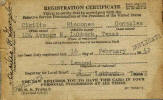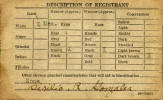 Selective Service Draft Card like this one was issued to every man over 18 years of age and law mandated that it be carried at all timers. Cisilio Gonzales, HQ HQ, Selective Service Draft Card like this one was issued to every man over 18 years of age and law mandated that it be carried at all timers. Cisilio Gonzales, HQ HQ,
Cisilio was barely twenty years old when this card was issued |
 Back of Draft Card Back of Draft Card
listed a few vital statistics, color of eyes (Brown) and hair (Black), complexion (Dark Brown) and racial classification (White-Mexican), a distinction not found on modern identification cards. On December 17 1942, in Pueblo, CO, he was inducted into the Army. |
 The Selective Service had been established in 1917 to support the induction of men for the last years of WW-I. Nearly 3 million men were called into service in 1917-1918. After the armistice in Europe, the draft was abolished. The Selective Service had been established in 1917 to support the induction of men for the last years of WW-I. Nearly 3 million men were called into service in 1917-1918. After the armistice in Europe, the draft was abolished.
However, in 1940 as things began heating up in Europe, the draft was reinstated and 18,633 men received the "Greetings" letter from Uncle Sam. During 1941, especially due to the Pearl Harbor attack the rate jumped to 923,842. In 1942 and 1943 more than 3 million men were inducted annually as WW-II raged on two fronts. The rate halved to 1.5 million in 1944 and dropped to less than one million in 1945. By 1946, the nation's needs nearly evaporated as only 183,383 men were called to duty as they followed in the footsteps of over 10 million men who had been subject to the draft in WW-II.
By 1947 the draft was again stopped as the end of the war permitted the nation to revert to an all-volunteer service.
The draft returned in 1948 and was in force for the next 23 years but the numbers never exceeded a half million in any one year (despite the combat needs in Korea and Vietnam) and were as low as 49,514 in it's final year of operation. The last man inducted entered the Army on June 30, 1973 and the nati9on's armed forces remain as all--volunteer services, over 30 years later. |


